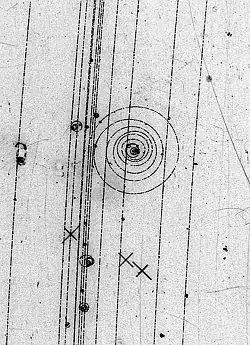When an electron exchanges a virtual photon with another electron or proton, is the virtual photon a real particle or just a mathematical construct? In string theory, the force carrier particles of the electromagnetic, strong, and weak forces are supposed to be open string bound to their d branes. But if virtual particles are just mathematical how can this be?
1 Answers
This started as a comment in reply to CuriousOne's comments but is getting too long, so I will answer the question if it does not become duplicate.
Observations are the basic definition of "real" in physics, as with life in general.
Observations start from classical particles, and in the last centuries a consistent mathematical model of mechanics, electrodynamics etc has been built up. These mathematical models are called theories and in addition to mathematical axioms have specific laws which connect the observations to the mathematics. Nobody is asking if the arrow that killed the bird is real, though its trajectory is accurately predicted given the initial conditions by classical mechanics. The mathematics involved, a parabola in this case is virtual in the sense that it can only be fitted/seen if all the points in space where the arrow passed are measured.
As one goes to the microcosm particles are being observed and studied classically, except that when reaching dimensions commensurate to h_bar these observed particles transmute in behavior, i.e. do not always follow classical physics trajectories and interactions.
The electron was discovered by its behavior as a particle and its trajectory seen in a cloud chamber in the beginning of the 20th century. Here is the track of an electron:
The red track can be fitted using classical mechanics and classical electrodynamics with energy loss in a medium.
As observations accumulated it became evident that these very small mass particles were a different beast and a different mathematical model was needed to cover their behavior. This was quantum mechanics which allowed the calculation of energy levels in atoms and developed into a program for calculating interactions between, crosssections and lifetimes etc. The wavefunctions, the solutions of the quantum mechanical equations, gave a probability density distributions when squared and explained the wave behavior of cumulative interference patterns for electrons .
The calculations were cumbersome until Feynman introduced the iconal representation of the mathematical perturbative expansions with the Feynman diagrams. These have a one-to-one correspondence with mathematical functions entering the integrals necessary for calculating crossections etc.
This diagram shows electron-positron annihilation.
All items in the icon have a mathematical expression which leads to writing an integral that can be calculated to give the probability of this annihilation happening, the crosssection to first order ( there are higher orders in the perturbative expansion for the calculation). The exchanged electron is called virtual, because it cannot be measured, in the mathematics it is a propagator function which has as a variable the momenta and energies that would define its mass, so its mass is not the electron mass as it should be. It has all the quantum numbers of the electron to ensure the correct conservation laws but not its mass. Particles off mass shell in the middle of Feynman diagrams are called virtual and are unmeasurable. Particles entering and leaving the diagrams are measurable and are what the experiment can record and are called real.
So virtual are a useful mathematical representation that can never be real because it cannot be measured at an instant of (x,y,z,t).
Then comes second quantization as discussed in the comments, which is a further level of unreality as far as the way it is being presented often in answers here. The whole space, (x,y,z) is covered by a field of operators, called creation and annihilation operators. These operate on the wavefunctions defined by quantum mechanical equations and are useful as a model in writing the Feynman diagrams . Their connection to real measurements comes through the Feynman diagrams. In this sense, the level of virtuality is one step higher . It is obviously mathematically satisfying to be thinking of fields and creation and annihilation operators, but it still is mathematics. The physics lies in the measurements and the accuracy with which the measurements fit existing data and predict new ones.
A statement "there are no particles just creation and annihilation operators" is a statement of belief, in a mathematical model, not a physics stament. Of course, the mathematical functions and operators exist, the way the parabola describes the track of an arrow. The parabola is not the arrow.
As for the string theory part of your question, it is just another level of virtuality, i.e. mathematical modeling, between numbers in measurements and mathematical modeling, as far as exchanges go. Whether real particles can be represented by vibrational levels of strings at the moment is at the level of hypothesis. It is still a mathematical model. If experiments can be designed that will measure the effects of the one-dimensional nature of the observed particles instead of the zero-dimensional as the standard model entries posit, is a matter for the future experimentalists.
- 424
- 236,935


